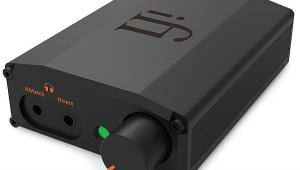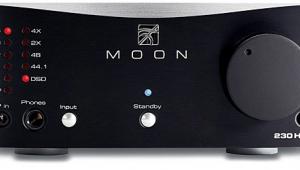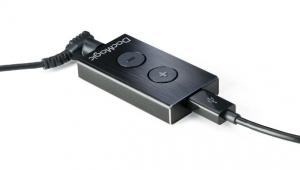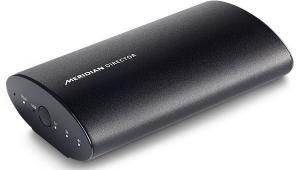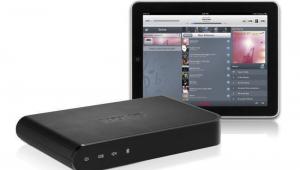iPhone Home Page 4
iWavit Premium 2012
I mentioned before that there were two basic ways to do iDevice remote control, but a firm called ThinkOptics has come?up with a third. Its iWavit Premium 2012 product includes not just an infrared dongle for conventional standalone iPhone remote control but also a USB dongle for computer control and integration, and an “IR Lightbar” to extend your A/V interface. Clearly, we’re going to have to break this one down. First, the basic remote.
iWavit’s substantial dongle plugs into the iPhone’s sync/charge connector in the usual way. But instead of one free universal-remote app, iWavit offers dozens, each an iOS virtualization of a single familiar hardware remote. The choices feature mass-market TV brands like Samsung, LG, Dynex, and Westinghouse, and the major systems’ cable boxes (Comcast, FiOS, etc.), but very few higher-end brands or projectors and no audio components at all.
Each iWavit “remote” includes four “pages” of buttons, which you move between via lateral swiping, spinning a groovy four-sided animation in the process.
Another ThinkOptics app, Tabula Rasa, lets you download and customize more remotes from premade code sets, guiding you nicely through the process.
However, my results were mixed when?I tested it out. Tabula Rasa showed a choice of four Onkyo code sets for my preamp/ processor. All “tested positive” via the app’s in-line power-key-response test, but none made much sense, either with my Integra pre-pro or with a current-model Onkyo receiver I also had on hand. Some keys, such as volume up/down, worked as expected, but many did nothing, and others issued nonsensical commands: Skip-right, for example, selected the pre/pro’s “Game” input.
Fortunately, Tabula Rasa has a quick and easy IR-learning routine, using an IR sensor built into the dongle. You can assemble a virtual remote button by button, IR-learning as you go, or you can begin with an existing remote and easily overwrite inoperative?or incorrect codes. This entails more work than simply selecting a fully working remote from a pre-coded selection, but it’s perfectly practicable.
However you assemble them, iWavit suggests its “Flow” app to order things. This puts all your remotes in a rotating carousel, styled after Apple’s own “CoverFlow” interface. Flick your thumb, and your remote collection spins; jab at the desired one as it passes, and up it comes.
In actual operation, the basic iWavit dongle hardware proved just adequate. IR power was modest, so I needed to aim the iPhone pretty much directly at the desired component’s IR window to get a response. The dongle also induced an approximately half-second delay, and it seemed fairly power-hungry: I couldn’t even get a full hour of (admittedly fairly intensive) iWavit use from my (admittedly fairly tired) iPhone 3GS.
Now on to the “iWavit Premium” extras. These consist of the Lightbar, a T-shaped LED array with a magnetic base that you may stick to a surface in front of a TV, a computer, or your gear stack, and a USB dongle that both powers the Lightbar and communicates with a computer.
The duo has two personae. First, if you simply power the Lightbar from any “live” USB port or USB charger and set it in front of your rack, the Lightbar acts as a broad- coverage IR blaster, flooding your gear with commands relayed by the iWavit dongle. This worked brilliantly, reliably conveying commands throughout my system, even to the TV some 90 degrees off-axis and 8 feet distant. Better still, the Lightbar receives these commands not directly via infrared but via radio frequency, so that commands work over long range.
Second, when the iWavit USB dongle is plugged into a PC or Mac, a new array of capabilities, delivered by yet another rotation of iWavit apps, is on tap: air mouse, wireless keyboard, Apple-device and Windows MCE controllers, and more. I tried the first three, and all worked usably. You also may call up these commands from within an iWavit remote app, so the potential for integrating a home theater PC/Mac or Apple TV into everyday system control seems substantial.
With its vast array of apps and substantial editing and linking capability, iWavit has plenty of power on tap, though its resources seemed a bit scattered at times and the efficacy of the online IR-code database frequently proved compromised — fortunately, the IR-learning path is easy. Nevertheless, with a bit of planning, and a false start or two, you should be able to cook up a pretty slick, four-screen system remote — plus many extras — with the Lightbar and USB/ dongle’s computer-control potential offering unique avenues to extend iWavit’s power.
Bottom Line
The takeaway from these three offerings seems pretty self-evident. If all you want is a basic remote control app for your iPhone that’s easily customized to your gear, the VooMote Zapper will do the job both elegantly and inexpensively. Those wanting to dig deeper have two options to choose for getting some virtual dirt under their fingernails. iRule will be the confirmed geek’s choice: It lets you get down in the trenches at an almost-coding level to design commands, graphics, and command-logic structures from the ground up. The somewhat less geeky types should find ThinkOptics’ iWavit Premium the ticket: It offers almost as much configurability as iRule, along with powerful hardware extensions, without demanding quite so much hardcore hands-on. We suggested at the outset that we’d find something for just about everyone. I think we’ve delivered.




